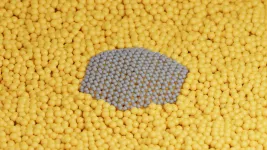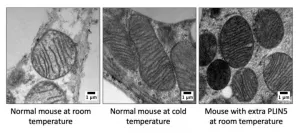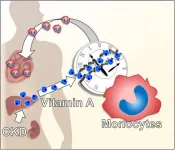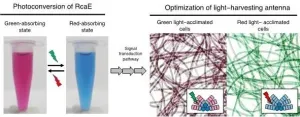(Press-News.org) Graphene may be among the most exciting scientific discoveries of the last century. While it is strikingly familiar to us--graphene is considered an allotrope of carbon, meaning that it essentially the same substance as graphite but in a different atomic structure--graphene also opened up a new world of possibilities for designing and building new technologies.
The material is two-dimensional, meaning that each "sheet" of graphene is only 1 atom thick, but its bonds make it as strong as some of the world's hardest metal alloys while remaining lightweight and flexible. This valuable, unique mix of properties have piqued the interest of scientists from a wide range of fields, leading to research in using graphene for next-generation electronics, new coatings on industrial instruments and tools, and new biomedical technologies.
It is perhaps graphene's immense potential that has consequently caused one of its biggest challenges--graphene is difficult to produce in large volumes, and demand for the material is continually growing. Recent research indicates that using a liquid copper catalyst may be a fast, efficient way for producing graphene, but researchers only have a limited understanding of molecular interactions happening during these brief, chaotic moments that lead to graphene formation, meaning they cannot yet use the method to reliably produce flawless graphene sheets.
In order to address these challenges and help develop methods for quicker graphene production, a team of researchers at the Technical University of Munich (TUM) has been using the JUWELS and SuperMUC-NG high-performance computing (HPC) systems at the Jülich Supercomputing Centre (JSC) and Leibniz Supercomputing Centre (LRZ) to run high-resolution simulations of graphene formation on liquid copper.
A window into experiment
Graphene's appeal primarily stems from the material's perfectly uniform crystal structure, meaning that producing graphene with impurities is wasted effort. For laboratory settings or circumstances where only a small amount of graphene is needed, researchers can place a piece of scotch tape onto a graphite crystal and "peel" away atomic layers of the graphite using a technique that resembles how one would use tape or another adhesive to help remove pet hair from clothing. While this reliably produces flawless graphene layers, the process is slow and impractical for creating graphene for large-scale applications.
Industry requires methods that could reliably produce high-quality graphene cheaper and faster. One of the more promising methods being investigated involves using a liquid metal catalyst to facilitate the self-assembly of carbon atoms from molecular precursors into a single graphene sheet growing on top of the liquid metal. While the liquid offers the ability to scale up graphene production efficiently, it also introduces a host of complications, such as the high temperatures required to melt the typical metals used, such as copper. When designing new materials, researchers use experiments to see how atoms interact under a variety of conditions. While technological advances have opened up new ways for gaining insight into atomic-scale behavior even under extreme conditions such as very high temperatures, experimental techniques do not always allow researchers to observe the ultra-fast reactions that facilitate the correct changes to a material's atomic structure (or what aspects of the reaction may have introduced impurities). This is where computer simulations can be of help, however, simulating the behavior of a dynamic system such as a liquid is not without its own set of complications.
"The problem describing anything like this is you need to apply molecular dynamics (MD) simulations to get the right sampling," Andersen said. "Then, of course, there is the system size--you need to have a large enough system to accurately simulate the behavior of the liquid." Unlike experiments, molecular dynamics simulations offer researchers the ability to look at events happening on the atomic scale from a variety of different angles or pause the simulation to focus on different aspects.
While MD simulations offer researchers insights into the movement of individual atoms and chemical reactions that could not be observed during experiments, they do have their own challenges. Chief among them is the compromise between accuracy and cost--when relying on accurate ab initio methods to drive the MD simulations, it is extremely computationally expensive to get simulations that are large enough and last long enough to accurately model these reactions in a meaningful way.
Andersen and her colleagues used about 2,500 cores on JUWELS in periods stretching over more than one month for the recent simulations. Despite the massive computational effort, the team could still only simulate around 1,500 atoms over picoseconds of time. While these may sound like modest numbers, these simulations were among the largest done of ab initio MD simulations of graphene on liquid copper. The team uses these highly accurate simulations to help develop cheaper methods to drive the MD simulations so that it becomes possible to simulate larger systems and longer timescales without compromising the accuracy.
Strengthening links in the chain
The team published its record-breaking simulation work in the Journal of Chemical Physics, then used those simulations to compare with experimental data obtained in their most recent paper, which appeared in ACS Nano.
Andersen indicated that current-generation supercomputers, such as JUWELS and SuperMUC-NG, enabled the team to run its simulation. Next generation machines, however, would open up even more possibilities, as researchers could more rapidly simulate larger numbers or systems over longer periods of time.
Andersen received her PhD in 2014, and indicated that graphene research has exploded during the same period. "It is fascinating that the material is such a recent research focus--it is almost encapsulated in my own scientific career that people have looked closely at it," she said. Despite the need for more research into using liquid catalysts to produce graphene, Andersen indicated that the two-pronged approach of using both HPC and experiment would be essential to further graphene's development and, in turn, use in commercial and industrial applications. "In this research, there is a great interplay between theory and experiment, and I have been on both sides of this research," she said.
INFORMATION:
Funding for JUWELS and SuperMUC-NG was provided by the Bavarian State Ministry of Science and the Arts, the Ministry of Culture and Research of the State of North Rhine-Westphalia, and the German Federal Ministry of Education and Research through the Gauss Centre for Supercomputing (GCS).
Engaged listening techniques such as eye contact, nodding and using key words to praise openness helps teenagers when they admit bad behaviour and share hurt feelings with their parents, a new study has shown.
University of Reading and Haifa researchers asked 1001 13 to 16-year-olds to watch a staged conversation between a parent and teenager about a difficult situation, with the parent adopting different body language and listening behaviour in different versions.
The participants who watched the versions where the parent was visibly attentive stated that they would have felt better about themselves as the teenager and would be more likely to open up about their ...
Water is weird - and yet so important. In fact, it is one of the most unusual molecules on Earth. It boils at a temperature it shouldn't. It expands and floats when it is in the solid-state. Its surface tension is higher than it should be. Now, new research published in the journal Nature has added one other equally strange property to water's list of oddities. The implications of this new revelation could have a remarkable impact on all water-related processes from water purification to drug manufacturing.
Stephen Cronin, professor of electrical and computer engineering at USC Viterbi School of Engineering, ...
Cancer researchers say they have established a new, life-extending treatment option for men with prostate cancer that has spread and become resistant to hormone therapy. The injected treatment combines a targeting compound with a radioactive isotope to irradiate and kill cancer cells.
An international clinical trial sponsored by Endocyte, Inc., a Novartis company tested the targeted radioligand therapy in study participants with advanced prostate cancer. All subjects had cancers that had spread to other organs and continued to progress after previous treatment with two kinds of drugs, androgen axis inhibitors and taxanes. The experimental treatment significantly extended survival, delayed ...
Leesburg, VA, June 4, 2021--According to a pilot study published in ARRS' American Journal of Roentgenology (AJR), the flexed elbow valgus external rotation (FEVER) view can improve MRI evaluation of the ulnar collateral ligament (UCL) in Major League Baseball (MLB) pitchers.
"The increased joint space width confirms elbow valgus stress with FEVER view," wrote corresponding author Thomas Knoblauch at the University of Nevada Las Vegas. "Diagnostic confidence increased, and additional UCLs were identified as abnormal."
Due to repetitive extreme valgus stress during overhead throwing maneuvers, UCL injuries remain common in throwing athletes. Because standard positioning for elbow MRI ...
DALLAS - June 4, 2021 - Increasing a protein concentrated in brown fat appears to lower blood sugar, promote insulin sensitivity, and protect against fatty liver disease by remodeling white fat to a healthier state, a new study led by UT Southwestern scientists suggests. The END ...
Fukuoka, Japan--According to the Global Burden of Disease Study 2017, close to nine percent of the global population lives with some form of chronic kidney disease, or CKD. Not only does the condition affect renal function, CKD has long been associated with increased risk of cardiovascular disease.
Now, in a new study that could aid the development of therapeutic drugs to reduce these cardiac complications, researchers led by Kyushu University have found an underlying molecular pathway that can explain how chronic kidney disease induces heart failure.
Studying mice, the researchers found that a key driver is the dysfunction of a type of white blood cell called a ...
Overview:
Certain cyanobacteria can change the absorbing light colors for photosynthesis using a green- and red-light sensing photosensor protein. A Japanese research group elucidated the molecular structure of RcaE, a representative member of the photosensors. They revealed the unique conformation of the bilin chromophore and the unique protein structure that potentially functions as a proton transfer route to bilin. They also demonstrated that RcaE undergoes protonation and deprotonation of the bilin chromophore during the green and red photoconversion. These results provide insights into how cyanobacteria evolved photosensors with diverse spectral sensitivities and contribute to the development of new photoswitches of ...
Coral insights into 1,000 years of seasonal changes in the Arabian Sea warn of significant impacts caused by global warming.
Every year, the southwesterly winds of the summer monsoon sweep down the Arabian Peninsula, pushing the surface waters of the Arabian Sea away from the coast and driving an upwelling of deep waters to the surface. This rising seawater is colder and less saline than the surface water and is rich in nutrients, providing energy for the various organisms living in the Arabian Sea and Indian Ocean.
Scientists from Japan, Taiwan and Germany, including coral reef scientist Dr. Tsuyoshi Watanabe of Hokkaido University, have uncovered evidence from corals off the coast of Oman suggesting that global warming is causing changes to the Arabian Sea that could impact the ...
Delicious to some, but a bitter bane to others' taste buds, vegetables like broccoli rabe, bok choy and turnips are a dinner staple ---and picky eater conflict --- around the world.
It all likely started in the mountains near present-day Afghanistan, where humans first domesticated turnips 3,500 to 6,000 years ago, according to a new study recently published in the journal Molecular Biology and Evolution. University of Wisconsin-Madison Professor of Botany Eve Emshwiller and her former graduate student Alex McAlvay (now an assistant curator assistant ...
HOUSTON-(June 3, 2021) - Results were released this week on a new treatment with the potential to improve the outcomes for patients with hereditary BRCA mutations and high-risk, early-stage breast cancer. These results represent the first time a drug that blocks cancer cells from repairing their DNA (called a PARP inhibitor) has been shown to significantly reduce the risk of breast cancer returning in high-risk patients following completion of standard chemotherapy, surgery and radiation therapy.
Titled "Adjuvant Olaparib for Patients with BRCA1 or BRCA2 Mutated Breast Cancer," the paper appears in the June 3 issue of the ...







